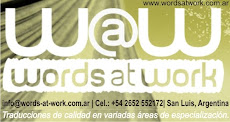by Gabriela Rosell
BA in Special Education - Early Stimulation Specialist
grosell@unsl.edu.ar
“Plan metodológico de integración de niños con TGD en una escuela común” (Methodological Plan for the integration of children with PDD in a common school environment) Award. Project presented by Professor Verónica Santiago and Ms. Melissa F. Gaibazzi - Stoikheia Institute- San Luis, at the V National Congress on "Learning Disabilities and Language" (“Trastornos del Aprendizaje y del Lenguaje”).
When it comes to promoting a pluralistic society, there are examples in the province of San Luis, Argentina and the world, unthinkable a few years ago. If we talk about the integration of students with special educational needs – who, in turn, live a condition of temporary or permanent disability - San Luis shows that he path can be made up as one goes along it.
The possibility of living, working, loving, educating and entertaining in diversity is throbbing in our society ; this is equivalent to growing and travelling a road of no return, to functioning as an inclusive society. We may not be able to live enough to see full inclusion, but our children and grandchildren will surely strengthen this movement that began in the second half of last century, with the help of the achievements in human rights.
Integration processes in all areas - school, sports, and labour, among others - are matrices, basal structures that will hold pro-inclusion steps in the future. In other words, without these integration processes, inclusion would not be possible in the future.
In this sense, all kinds of events are organized in order to disseminate experiences. In our province, the V National Congress on Learning and Language Disabilities took place on November 19th and 20th 2010. Prestigious speakers, such as Dr. Juan Narbona García (Spain), among other leading professionals were present in this event. The objective of the conference was to promote advancements and updates in the field of Learning, Communication and Language Disabilities. The crux of all presentations was the improvement of the life quality and the resources needed to support people with disabilities and their families with a global approach that includes integrity in interactions with the environment in which they grow up.
San Luis was represented by different professionals. The lecture given by Professor of Special Education Veronica Santiago, Principal of Stoikheia Institute, and by Melissa Gaibazzi, B.A in Speech Therapy (who also specializes in Autism and PDD - pervasive developmental disorder- and who is a member of Children's Medical Center “Pediátrica San Luis” - San Luis Pediatrics) is worth mentioning. Both professionals spoke before an audience made up of people working in provincial, national and international organizations. The main topic of the speech was the integration actions that this institution is carrying out for students with special educational needs, and who also have autism and PDD. This situation was virtually unthinkable a few years ago. Ms Santiago and Ms Gaibazzi also spoke about the apparatus designed to give an appropriate educational response to their students, watching the support needs of students with autism and PDD, as well as the requirements of their pairs (children without disabilities) and their families, faculty and school staff. Among other issues, they highlighted the benefits of teamwork, the importance of external support to enrich the educational intervention, the importance of inviting the family to participate and enhancing their role, the urgent need to work with the environment. A project like this must include the integrated child's peers, as well as all the teachers of the institution, the non-teaching staff (janitors, secretaries, etc) and parents.
Finally, it is noteworthy that this work has been evaluated by the Scientific Committee and has been awarded a prize to the best presentation, which is a pride for our province, a role model, an incentive to all those who are doing their best in favour of a plural society (from the place that each one occupies in society), in one way or another. It is necessary to highlight the willingness and openness of Professor Gabriela Bodar, Stoikheia Institute's legal representative and that of the management team, who opened the doors of the institution to implement the school integration system, created out of the needs of each group of students.
The closing ceremony of Stoikheia Institute’s 2010 school year, was an emotional, captivating, and absolutely inclusive event. The viewers could see that children with disabilities and their families could access the same creative, artistic and academic proposals than the rest of their classmates, with the support that each one needs. Parents highlight the successful integration system, and therefore understand that their children, as well as their peers with disabilities, are benefited from these actions in this context. This means that what the professionals presented in the Congress could be seen at work .
We are witnessing today a large number of institutions in our province, who are going the same way, perhaps with different methodologies for their proposals, but definitely doing their best for the sake of each child and respecting the right of common access to education for persons with disabilities.
Congratulations to all!



